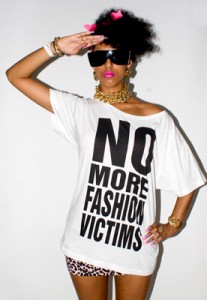 This article has originally been published online on the Bagsful blog on December 19th 2010, and is republished with permission.
This article has originally been published online on the Bagsful blog on December 19th 2010, and is republished with permission.
By: Bryony Moore, @Bagsful, Researcher and Writer for the Ethical Consumer
Now this isn’t a question I’d have thought to ask, since movements generally result from the convergence of numerous individuals’ ideas, rather than being attributable to a single “inventor”.
However, whilst browsing the Katharine Hamnett website recently, I spotted the rather outlandish claim that KH herself had “invented environmental and ethical fashion.”1 Having grown up with ethical fashion, and not consciously been witness to it’s uprising, I couldn’t personally say whether this was true or not, but I have to say I felt compelled to investigate.
Plus, it’s a looking-back-and-taking-stock time of year, so as we approach the turn of a new decade, why not indulge a little reflection on the roots of the ethical fashion movement, and see how far we’ve come…
KH
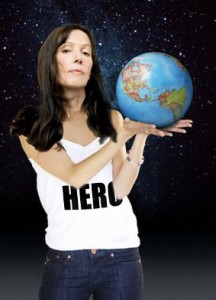
Katharine Hamnett made her name and fortune creating garments printed with bold, political statements. She wasn’t afraid to cause a scene, (“58% DON’T WANT PERSHING” – 1984) and still isn’t, (“NO WAR, BLAIR OUT” – 2003).
Over to Katharine to explain, in her own words, what drove her into the arms of ethical fashion:
“By 1989 I was bored with success. Something was missing.
I discovered the fashion industry was responsible for a living environmental nightmare. Millions of people in the garment sector were working in conditions of slavery. I was horrified and felt a moral imperative to do something.”
“From 1989 to 2003 I tried to change the industry from within. Forget it. From 2003 to 2007 I realised consumers care even if industries and politicians don’t. Industries must sell but consumers don’t have to buy. I decided to raise consumer awareness of issues in the clothing industry.
Returning from a visit to Mali with Oxfam in 2003, having seen firsthand the devastating human suffering amongst conventional cotton farmers, she decided that “the solution was organic cotton,” and decided to drive demand for this ‘white gold.’
So does the planet owe KH a huge thank you for the ethical fashion scene today, or is there more to this movement than a one-woman band?
Green Roots
The environmental movement kicked off after the publication of Rachel Carson’s book Silent Spring in 1962, and we saw the first images of the Earth from space in 1968.
In 1972, the United Nations Conference on the Human Environment was held in Stockholm, and for the first time united the representatives of multiple governments in discussion relating to the state of the global environment. This conference led directly to the creation of government environmental agencies and the UN Environment Program. The United States also passed new legislation which formed the foundations for current environmental standards.
According to Lucy Siegle’s 2008 article on BBC Threads, eco fashion began is a direct descendant of this eco-movement of the 1970’s, with an increasing awareness of the chemicals present in textiles. People’s main concerns were the health implications of these substances, and eco-labels such as Germany’s Blue Angel sprang up.
Workers First
 However, the struggle for a more ethical textile industry began with people, who were battling it out for labour rights long before they turned their attention to the environment.
However, the struggle for a more ethical textile industry began with people, who were battling it out for labour rights long before they turned their attention to the environment.
The concept of ‘sweatshops’ emerged in London & New York in the late 1800’s. Numerous strikes by women over pay and right to form trade unions resulted in the founding of the International Ladies’ Garment Workers’ Union in 1910. By bargaining collectively, workers had more power to negotiate better working conditions and pay.
Unfortunately, having shunted production overseas, this battle for representation is still being fought in the garment factories around the world.
In 1919 the International Labour Organization was formed, under the League of Nations and then the United Nations, which sought to address the plight of workers the world over. ILO guidelines for minimum standards of workers’ rights form the backbone of conscientious companies’ policies today.
Recent Movements
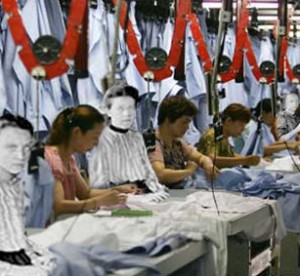
The mid 1990’s was perhaps the decade when the biggest sea change in awareness of garment workers’ plight occurred and is where my own memory of these issues starts.
During this time, numerous sweatshop scandals were publicised by the mainstream media, sparking outrage amongst the public and forcing companies to tackle the problems endemic in their supply chains.
Companies affected included Nike, and Kathie Lee Gifford’s Wal-Mart label was exposed for its use of child labour in a Central American factory in 1996 and 1997.
The Clean Clothes Campaign began in 1989. The CCC is now an alliance of organisations in 15 European countries which educates and mobilises consumers, lobbies companies and governments, and offers direct solidarity support to workers as they fight for better working conditions.
So who were the first ethical fashion companies?
- Bishopston Trading Company is a fair trade company that has been providing employment for the people of South Indian village K.V.Kuppam since 1985.
- Ethical brand Komodo was established in 1988.
- In 1989, Katharine Hamnett’s Clean up or Die collection highlighted the previously unheard of side effect of conventional cotton agriculture, deaths and pesticide poisoning. Another project in which Hamnett became involved is the Green Cotton 2000 campaign, launched in conjunction with the Pesticides Trust in 1990, which aimed to reduce the harmful waste and discharged effluent produced by the textile industry.
- 1990 Lynda Grose co-founded the Esprit Ecollection, the first complete ecological clothing line distributed internationally by a major corporation.
- In 1991 Levi’s became first brand to implement a code of conduct, due to the discovery of sweatshop conditions when it moved its manufacturing outside of the US in the 80’s.
- Conscious Earthwear founded in the early 1990’s by Sarah Ratty, the designer who now brings us Ciel.
- Giorgio Armani’s first eco project, the development of a process to recycle denim began in 1995.
- 1997 – People Tree Japan launched and was launched in the UK in 2001.
- 1998 – Abi & Thomas Petit say they pioneered the introduction of ethical textiles into the UK, with Gossypium.
- Organic standards for textiles launched in February 2003 by the Soil Association
- Fairtrade label for cotton introduced into the UK market in 2005.
- 2006, the first ever Estethica is held – the ethical section of London Fashion Week.
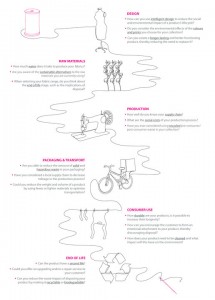
Where are we now?
While to say that KH “invented” ethical fashion would be to denounce the efforts of those small brands like Gossypium that worked equally as hard at the beginning to set up the infrastructure that the ethical fashion sector could later learn from and develop. And the big brands like Giorgio Armani and Esprit who were willing to take a risk on ethical fashion at its very beginnings. We have to credit her with showing rare dedication to creating an ethical fashion industry that is, even today, rare among designers who’ve made it big in the mainstream fashion world.
Back in 1989 when KH decided her success “was no longer enough,” her typical customer would’ve been unaware of the issues surrounding the fashion industry, as indeed were most people.
However, a Vogue article (and you don’t get much more mainstream fashion that Vogue…) on fashion in the noughties, listed the acceptance of ethical fashion as one of the things this century would be known and remembered for.
This has to be partly due to the foundations laid by KH.
There can be no doubt that her slogan tees inspired a new generation of consumers AND designers to think about where their clothes came from. She also made it cool to wear your ethics on your sleeve, which she still does to this day, for a whole new generation of fashion-lovers.
Vogue says the noughties is the decade in which ethical fashion hit the mainstream. So, as we stand on the brink of the next decade, what’s next for ethical fashion?
Mark Swire, co-founder of Frank&Faith, says on the company’s blog that “challenges of scale and breaking into the mainstream against high street multiples and supermarkets will continue to be the major challenge.”
It’s no secret that many ethical fashion brands are struggling. As Swire points out that in 2006 People Tree had yet to turn a profit, making a loss of £366,000, (I can’t seem to find any updates on that figure online), and Ascension (formerly Adili) was sold for just £1 in March 2010 after failing to fulfil its ambitions. High-end e-tailers Devidoll currently have a message on their website saying they’re “on sabbatical.”
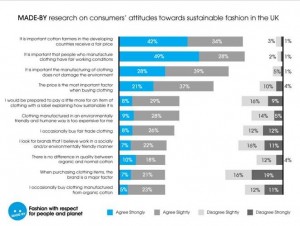 Clearly, it’s tough for ethical brands to achieve commercial success, since they’re working against economies of scale of bigger companies. Added to that competition from the increasing ranges of Fairtrade and organic garments on sale in supermarkets, plus the current economic climate and it just gets tougher. But with continued awareness-raising from campaigners, and companies like People Tree selling garments at prices comparable to the high street, hopefully over the next century we’ll see more and more people switching to ethical clothing as a viable and affordable alternative.
Clearly, it’s tough for ethical brands to achieve commercial success, since they’re working against economies of scale of bigger companies. Added to that competition from the increasing ranges of Fairtrade and organic garments on sale in supermarkets, plus the current economic climate and it just gets tougher. But with continued awareness-raising from campaigners, and companies like People Tree selling garments at prices comparable to the high street, hopefully over the next century we’ll see more and more people switching to ethical clothing as a viable and affordable alternative.
This encouraging study published by Made-By illustrates that consumers are placing ever greater importance on ethical issues surrounding the consumption of fashion products. Good working conditions and fair prices were the two main ethical concerns. Encouragingly, the study also reveals that 75% of consumers recognise the social and environmental benefits of sustainable fashion as important and that 30% of shoppers in the UK currently seek to purchase sustainable products from companies that operate in a social as well as an environmentally-friendly way. It did add that consumers do object to the higher prices that can come with sustainable production and ethical supply chain practices. But still, that’s 75% of consumers that are open to the idea. Now all that remains to be done is to demonstrate to them the real human and environmental value of ethical fashion…

